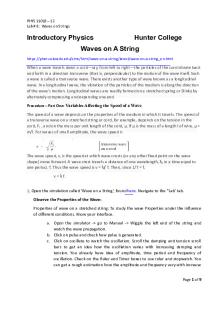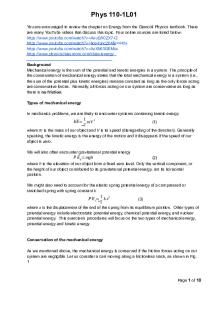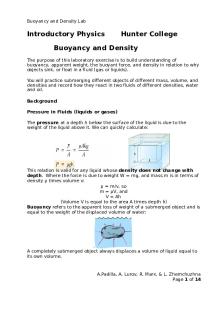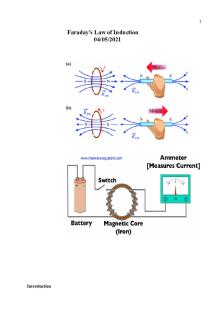PHYS Lab Report 3 PDF

| Title | PHYS Lab Report 3 |
|---|---|
| Course | General Physics I: Algebra Based |
| Institution | New York City College of Technology |
| Pages | 7 |
| File Size | 372.7 KB |
| File Type | |
| Total Downloads | 97 |
| Total Views | 171 |
Summary
Linear Uniform Accelerated Motion Lab report #3
...
Description
PHYSICS 1433 LAB REPORT
Linear Uniform Accelerated Motion Touheda Khanom 03.04.2020
OBJECTIVES The purpose of the laboratory was to find the velocity using the length of the flag and measuring of the acceleration of the moving cart and to verify the kinematic equation for uniformly accelerated motion. Moreover, to find the distance between photogates and % differences for distance. Also, to determine how the slope of the velocity graph relates to the acceleration.
THEORETICAL BACKGROUND When an object moves it changes its value with the time. Velocity is the rate at which position changes. To find the velocity of an object we used the following formula:
v=
Δx Δt
When an object changes its velocity with time, the object is said to be accelerating. When velocity changes at the same rate throughout the motion it is called a linear motion with constant speed. Motion with constant acceleration is known as uniform accelerated motion. We used the following formula to find acceleration:
a= In the formula above v 2 and v 2
1
v 2−v 1 t 2−t 1
is the final velocity and the initial velocity and at the instants, t
and t 1 represent the final time and initial velocity. To find the average acceleration we used
the following formula:
a=
v − v(initial) t
The displacement x for uniformly accelerated motion at a later time t. To find the distance between photogates we used the following formula: 2 x = v(initial) t + at2
Using the velocity and time in the laboratory plot a graph. According to the acceleration equation, the slope of the straight line in the graph is equal to the magnitude of the acceleration.
As a result, by finding the slope in the graph we are determining acceleration. PROCEDURE 1. We set up the dynamics track and the photogates to find the distance between photogates and find the x value of the table. 2. We used two photogates in this lab. We connected the digital photogate 1 accessory and plugged into digital channel 1 on the science workshop interface box. 3. Then we connected the digital photogate 2 accessory and plugged into digital channel 2 on the science workshop interface box. 4. We set up the sensors in the software opening the data studio window we clicked to create an experiment. 5. We then set up the timers to measure the initial velocity of the cart to measure the initial time and the final velocity and the final time. 6. We placed the photogate at a distance of x = 0.04 m. 7. We placed the cart at the starting point position and then released it from the same point for each run. Then we clicked start after passing through the photogates click stop and record the values.
GRAPHS
SAMPLE CALCULATIONS The following were given data: Length of the flag ΔL = 0.04 m The following formulas were used in the laboratory: To find the initial velocity used the following formula for the data:
v initial = v intial =
ΔL Δt°
0.04 m 0.0801 s
To find the final velocity used the following formula for the data:
v = v =
ΔL Δt
0.04 m 0.0578 s
To find the acceleration used the following formula for the data: a =
a =
v − v(intial) t
0.6920 m − 0.4994 m 0.8222 s
To find the acceleration used the following formula for the data: 2 x = v (initial) t + at2
(0.2343 m/s 2 )(0.8222 s) 2 x = 0.4994 m/s (0.8222 s) + 2
To find the % difference used the following formula for the data: |V 1−V 2|
% difference for x = (V 2+V 1)/2
| 0.9−0.89|
= (0.89+0.9)/2
× 100
× 100
To find the distance used the following formula for the data:
v 2 − v 2 (initial) x= 2a x=
(0.6920) 2 −(0.4994) 2 2(0.2343)
QUESTIONS 1. Does a speedometer in a car measure speed or velocity? Does an odometer in a car measure distance or displacement? -
Speedometer measures the speed of an object and not the direction of an object. It does not measure velocity. On the other hand, an odometer only measures the total distance traveled by an object rather than displacement.
2. If the velocity of an object is zero, does its acceleration have to be zero? -
If the velocity of an object is zero, then the object will not accelerate. So, when velocity is zero, acceleration will also be zero.
3. A cart has a constant acceleration of a=2 m/s^2. At a certain instant, its speed is 5 m/s. What is its speed 2 s later and 2 s earlier? What is its average speed during the time interval of 4 s?
a=
v−v(intial) t
v = at + v(initial) = 2(-2)+5 (When t = 2 s earlier) = 1 m/s v = at + v(initial) = 2 (2) + 5 = 9 m/s (When t = 2 s later) Vavg =
9−1 2 −(−2)
= 2 m/s
CONCLUSION Based on our data and calculations, we discovered that the relationship between the position, velocity, and acceleration and understood the concept of acceleration. Moreover, we determined the graphs of position and velocity vs time for an object’s motion. We determined the slope of the velocity graph related to the acceleration.
...
Similar Free PDFs

PHYS Lab Report 3
- 7 Pages

Phys 208 Lab Report # 3
- 3 Pages

Phys lab report 2
- 14 Pages

Phys lab 4 - Lab report
- 10 Pages

Phys lab 8 - Lab report
- 9 Pages

Phys lab 5 - Lab report
- 10 Pages

Phys lab 10 - Lab report
- 14 Pages

LAB 3 PHYS 1429
- 3 Pages

LAB Report #4 phys 224
- 5 Pages

PHYS 215 Vectors - Lab Report
- 2 Pages

Lab report 4 int phys
- 4 Pages

Phys lab 6 - Lab report 6
- 13 Pages

Lab #3-3 - lab report
- 10 Pages
Popular Institutions
- Tinajero National High School - Annex
- Politeknik Caltex Riau
- Yokohama City University
- SGT University
- University of Al-Qadisiyah
- Divine Word College of Vigan
- Techniek College Rotterdam
- Universidade de Santiago
- Universiti Teknologi MARA Cawangan Johor Kampus Pasir Gudang
- Poltekkes Kemenkes Yogyakarta
- Baguio City National High School
- Colegio san marcos
- preparatoria uno
- Centro de Bachillerato Tecnológico Industrial y de Servicios No. 107
- Dalian Maritime University
- Quang Trung Secondary School
- Colegio Tecnológico en Informática
- Corporación Regional de Educación Superior
- Grupo CEDVA
- Dar Al Uloom University
- Centro de Estudios Preuniversitarios de la Universidad Nacional de Ingeniería
- 上智大学
- Aakash International School, Nuna Majara
- San Felipe Neri Catholic School
- Kang Chiao International School - New Taipei City
- Misamis Occidental National High School
- Institución Educativa Escuela Normal Juan Ladrilleros
- Kolehiyo ng Pantukan
- Batanes State College
- Instituto Continental
- Sekolah Menengah Kejuruan Kesehatan Kaltara (Tarakan)
- Colegio de La Inmaculada Concepcion - Cebu


